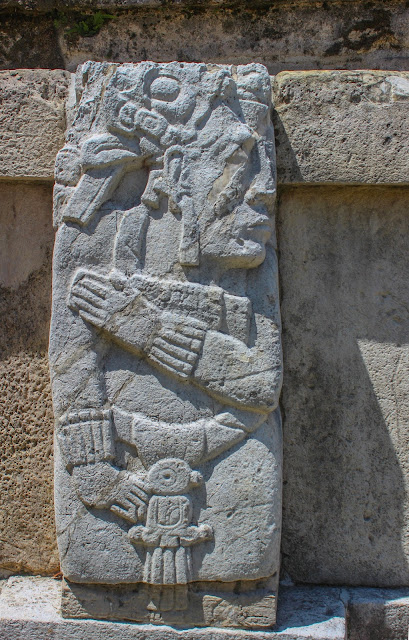Palenque is a Mayan city located at the base of a mountain range in the State of Chiapas, Mexico. It is a UNESCO World Heritage Site and considered by many to have the most beautiful of Mayan buildings. It was occupied from 200 to 900 CE. Many of the rulers of Palenque are known, beginning in 431. The most famous was Kinich Janaab Pacal, also known as Pakal the Great, who ruled from 615 to 683. He created a dynasty which, over three generations (four rulers), increased in prosperity. Pakal's son, Chan Bahlum, ruled from 684 to 702, then another son, K'an Joy Chitam II, ruled from 702 to 720, and a grandson, Akul Mo' Naab, ruled from 721 to 736. Monumental building ceased about 800 CE, after hostilities with other cities.
 |
| View of the Palace Complex (right) and Temple of Inscription (left) from the Temple of the Cross. |
 |
| Beautiful flowers. |
There are springs in the nearby mountainside which are channeled by canals and aqueducts which gave it its ancient name, "The Place of the Great Waters."
The Temple of the Skull, also known as the Temple of the Dead Moon and Temple XII, is one of the first buildings we saw. It is named after a decoration on one of the pillars. It shares a long rectangular platform with the
Temple of the Red Queen, also known as Temple XIII, which gets its name from a woman found in a sarcophagus covered with bright red cinnabar powder. A theory is that she was the wife of Pakal as her burial chamber was near Pakal's and she had a burial mask and other items similar to those found in the sarcophagus of Pakal. Both were built in the 8th century on layers of other buildings built 100 years earlier.
 |
| Temple of the Skull. |
 |
| Temple of the Skull behind these beautiful flowers. |
 |
| Temple of the Skull. |
 |
| Temple of the Queen with the awning over it in the center. Above it is the Temple of Inscription and the Palace Complex is to the left. |
 |
| Palace Complex from the Temple of the Red Queen. |
The Palace is the central complex in Palenque. It is a complex of connected and adjacent buildings and courtyards. It was the center of the city. It was a royal residence and court and had accommodations for others, including military personnel. It was begun by Pakal and enlarged and remodeled in 654, 661 and 668 CE. It includes a four story Observation Tower, built about 721, and baths and saunas which were supplied fresh water by the aqueduct water system.
 |
| Temple of the Foliated Cross. |
 |
| Temple of the Foliated Cross to the right and Temple of the Cross is upper left. |
The Temple of the Sun is on a much smaller stepped-pyramid and is associated with the God GIII.
 |
| Temple of the Sun (on the left) as viewed from the top of the Temple of the Cross. Temple IV is to the right. |
 |
| Temple of the Sun (to the left) and Temple IV (to the right). |
Temple IV was built around 702 CE after the death of Chan-Bahlum, by his brother Chitam.
 |
| Temple of the Count. |
 |
| Part of what I believe is called the North Complex, near the Temple of the Count. |
When we visited the temperature was about 98 degrees and the humidity was over 90%. Without continually hacking back the jungle, it just overgrows the buildings. This is much later than
Teotihuacan and has obviously borrowed from it (note the steps up the pyramids). We visited with our friends Kasey and Julia who are currently living in Villahermosa, about two hours away by car.


































Looks like an awesome place.
ReplyDeleteI think this is one of my favorite places in all of Mexico. It is so vast, so mysterious, so Indiana Jones-y. We were lucky to be there on a relatively quiet day--perfect for letting our imaginations link to the past!
ReplyDelete